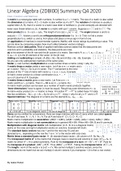Summary
Linear Algebra (2DBI00) 2020 Summary
- Course
- Institution
EN: Linear Algebra and Applications (2DBI00) is a course taught at Eindhoven University of Technology. It is an elective that is recommend for first-year Bachelor Computer Science and Engineering students. It is given in the fourth quartile and forms the basis on linear algebra. Linear Algebra and...
[Show more]



